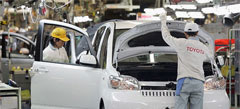| |
|
| |
|
 |
Supply
Chain by the Numbers |
| |
|
| |
- Aug. 10, 2017 -
|
| |
|
| |
|
| |
|
| |
States Line Up for New Toyota Factory; West Coast Longshoremen in Surprising Contract Move; How Much have US Freight Volumes Grown Since the Bottom of Recession? Intel Invests Big in Autonmous Driving Technology |
| |
|
| |
| |
| |
11 |
 |
| That's how many states are angling to be selected as the site for the planned new joint Toyota and Mazda assembly plant that was announced last week. And that shouldn't be a surprise – the new factory will involve some $1.6 billion in investment, and employ 4000 workers when it opens in 2021. The shortlist, it was reported this week, includes: Alabama, Florida, Kentucky, Illinois, Indiana, Iowa, Michigan, Mississippi, North Carolina, South Carolina and Texas. The Wall Street Journal reported that Toyota has been exploring those states for a plant location for more than six months. Working through real-estate services firm JLL, until last week Toyota had been keeping its identity secret, according to reports. It's worth noting that the south and southeast have become the preferred location for many foreign auto manufacturers because of the business-friendly labor laws of many of the region's states, with all being right-to-work states – and unions consistently losing elections, most recently a big defeat at a Nissan plant in Mississippi just earlier this week. Some reports have the Magnolia state as having the early lead, but tax deals and other incentives have to play out. |

|
|
| |
| |
|
|
|
Amazingly, that is the length of the contract extension, agreed to in mid-contract, that West Coast port workers approved last week, moving the expiration date from 2019 to July 1, 2022. A breakdown in contract talks nearly three years ago between the ILWU and the ports and terminals, represented by the Pacific Maritime Association, slowed cargo movement and cost the economy billions of dollars as containers were held up on the docks for weeks. So why the contractual harmony now? First, the contract extension will raise wages, maintain health benefits, and increase pensions for roughly 20,000 workers at 29 ports across California, Oregon and Washington. Second, West Coast ports are under a variety of pressures – notably the expanded Panama Canal – and this move was certainly in part meant as a show of stability in terms of operations for another five years. The extension was approved by some 67% of West Coast dock workers. "Nobody wants to see a repeat of the problems that were experienced in 2014-2015, and this remarkable sign of good faith on the part of both labor and management ensures that such a situation will be avoided," said the National Retail Federation's Vice President for Supply Chain and Customs Policy, Jonathan Gold.
|
| |
| |
|
| |
| |
$15 Billion |
|
That is the remarkable price chip giant Intel is paying to acquire Israeli autonomous driving technology provider Mobileye, as yet another company jumps on the self-driving technology bandwagon, though it turns out Intel already had an Automated Driving business unit. Mobileye specializes in collision detection and mapping technology. Intel will bring its expertise to create automated cloud-based driving solutions. Together the companies will combine efforts around connectivity, computer vision, data center, sensor fusion, high-performance computing, localization and mapping, machine learning and artificial intelligence, Intel says. Is that all? Intel's interest may be in the core autonomous vehicles themselves, but clearly also of interest will be managing the insane amounts of data autonomous cars and trucks will eventually generate. Intel and Mobileye began collaborating just in July under a three-way partnership with BMW to develop a fleet of 40 autonomous vehicles by the second half of 2017. This really will be here someday, and maybe soon.
|
| |
| |
|
|
|
| |
 |
 |
| |
|
|
| |